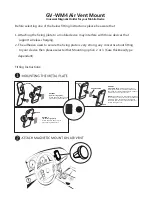
Safety instructions
TIA’s Safety Information
This includes complete security information on wireless phones
from TIA (Telecommunications Industry Association).
It’s required, for CTIA Certification, the inclusion in the user manual of
text covering pacemakers, hearing aids and other medical devices.
It’s
encouraged the use of the remaining TIA language when relevant.
Exposure to Radio Frequency Signal
Your wireless handheld portable telephone is a lowpower radio transmitter and receiver.
When it is ON, it receives and also sends out radio frequency (RF) signals.
In August, 1996, the Federal Communications Commissions (FCC) adopted RF
exposure guidelines with safety levels for handheld wireless phones. Those
guidelines are consistent with the safety standards previously set
by both U.S. and international standards bodies:
ANSI C95.1 (1992) *
NCRP Report 86 (1986)
ICNIRP (1996)
Those standards were based on comprehensive and periodic evaluations of the
relevant scientific literature. For example, over 120 scientists, engineers, and
physicians from universities, government health agencies, and industry reviewed
the available body of research to develop the ANSI Standard (C95.1).
* American National Standards Institute; National Council on
Radiation Protection and Measurements; International
Commission on Non-Ionizing Radiation Protection.
The design of your phone complies with the FCC guidelines (and those standards).
Phone Operation
NORMAL POSITION:
Hold the phone as you would any other
telephone with the
antenna pointed up and over your shoulder.
Safety instructions
11
Summary of Contents for X240DSF
Page 1: ...ENGLISH USER GUIDE LG X240ds MFL00000000 1 0 www lg com ...
Page 19: ...01 Custom designed Features ...
Page 22: ...02 Basic Functions ...
Page 46: ...03 Useful Apps ...
Page 65: ...04 Phone Settings ...
Page 79: ...05 Appendix ...
Page 86: ......













































